If for any reason you ever have a VW dealership or other automotive repair facility
work on your air conditioning unit in the VW portion of the cab, they will need
to know that any factory supplied sticker under the hood which relates to the amount
of refrigerant used in the system may need to be disregarded. The stock VW air conditioning
system may have been modified by Winnebago to include the overhead outlets in the cab
which blow air into the rear coach area.
If you are unfortunate enough to be faced with
a failed compressor on your Rialta, you have several choices. You can opt to pay
for an exact replacement from VW at their exaggerated prices. You'll end paying
nearly $2,000 and unfortunately have the same type of compressor that has been subject
to so much premature failure.
Another choice involves some retrofitting of a custom made valve
block made by one member of the Rialta Tech Group on Yahoo. Check the message files
for the subject thread. Supposedly this would allow the installation of a different,
more robust Sanden compressor.
And finally, yet another choice is to have your existing compressor
rebuilt by any of a number of rebuilding facilities. This usually results in the
cheapest total over cost but you are still at the mercy of the mechanic who is doing
the installation. Even in such cases, it is imperative that the mechanic follow
a strict set of guidelines in re-installing the rebuilt compressor. If anyone knows
of a good rebuild source, please let me know.
| 1. Why do I need to use an exact amount of
Freon? |
| 2. What is a "Liquid Charge", and why is
it dangerous? |
| 3. What causes clutch failure? |
| 4. What causes compressor failure? |
| 5. Why should I use R134a refrigerant? |
| 6. What does humidity have to do with my
air conditioner? |
| 7. Where does the "High Side" begin? |
| 8. Just what is this "Black Death"? |
| 9. What exactly does a drier dry? |
| 10. What is your position on flushing? |
| 11. What about system leaks? |
| 12. What does all this A/C jargon mean? |
| 13. What is a ton of refrigeration? |
| 14. How many different condensers are there,
and which can be flushed? |
| 15. What causes excessive clutch cycling? |
| 16. Why should I worry about ESD? |
| 17. Can compressors take all that heat? |
| 18. Does it matter what oil I use? |
| 19. What are the "Three laws of air conditioning"? |
| 20. What should be done when installing
a compressor? |
| 21. How does an automotive A/C system work? |
| 22. What about "Low Air flow"? |
| 23. My clutch (or switch) does not function,
what can I do? |
| 24. Is a little moisture in the system really
such a big deal? |
| 25. What are the basic A/C systems? |
| 26. How are clutch cycling switches different? |
| 27. Are your compressors compatible with
R12 or R134a? |
|
| Why do I need to use an exact amount
of Freon?
Today's A/C systems use
smaller amounts of Freon. No longer is it 2 to 4 lbs, but rather 18 to 38 oz.
With tight compressor tolerances and lubricant mixed with the Freon, the mixture
must be just right to enter the compressor as a mist. Wrong mixtures will either
under lubricate or slug the compressor causing premature failures. You don't
know how much liquid Freon is in a system so you should recover the old Freon,
evacuate and add the correct charge. Always check the OEM spec for the correct
charge.
Back to the FAQ
|
|
| What is a "Liquid Charge", and why
is it dangerous?
A "Liquid Charge" is any
charging of the A/C system using Freon which enters the A/C system in a liquid
state as opposed to a gaseous or Vapor state.
Warning! Charge A/C System with Freon
as Vapor, not Liquid!
If a charging hose is long enough you might get away with using liquid refrigerant
because the liquid will partially change to a gas in the hose. The odds are
not in your favor. More often you will freeze and shatter the compressors valves
when the refrigerant hits the valves as a liquid. This happens in mere seconds,
which is why we recommend charging the A/C system with the engine off.
Back to the FAQ
|
|
| What causes clutch failure?
Some common causes for
clutch failure:
1. Bearing failure.
2. Air Gap: Between the outer plate (hub) and the belt/rotor (.016 -. 030
inch) Note! Air gap varies with compressor type - check OEM specs.
3. Shorted Coil - Due to improper polarity or weak/burnt winding.
4. Low voltage at coil will cause coil to overheat due to slippage.
5. Locked Compressor: Excessive discharge pressure - Check for restricted
condensers, receiver/driers or an oil over charge
6. Belt is wrong type, wrong size, miss-aligned or loose.
Back to the FAQ
|
|
| What causes compressor failure?
Some common causes for compressor failures are:
LACK OF USE:
Compressors not run regularly will be starved for lubrication when they are
turned on. This causes excessive ware until the oil again reaches the compressor.
It's best to use the A/C once a week for a few minutes.
FAILURE TO FLUSH SYSTEM:
Compressors and hoses wear causing bits and pieces to mix with the oil. This
sludge gets into the compressor and can cause it to seize. Failure to properly
flush or using flush that leaves a residue is a primary cause of failure.
EXCESSIVE HIGH OR LOW
PRESSURE:
Condenser fans can quit due to bad connections or defective motor windings that
get too hot. This creates excessive head pressure and heat that can lock up
or damage a compressor. Loose connections at the coil can cause high resistance
and low voltage causing clutch slippage. Low refrigerant charge will cause lack
of lubrication getting to the compressor. Painting condensers will insulate
them from efficiently removing heat and increase head pressure in the compressor.
IMPROPER FREON OR OIL
CHARGE:
Compressors manufactured after 1990 have smaller capacity, therefore use less
refrigerant and oil and are extremely sensitive to inadequate amounts of oil.
The wrong type of oil may break down in high heat conditions. R134a systems
are more sensitive to lubrication than R12 systems. An over charge of oil can
clog the condenser, the orifice tube or expansion valve and starve the compressor
of oil. R12 systems use mineral oil and R134a systems use PAG or Double End
Capped PAG Oil (always check the OEM specs)
REFRIGERANT BLENDS
They can affect seals and O-rings, causing them to leak, swell or otherwise
deteriorate and it can happen relatively quick.
Back to the FAQ
|
|
| Why should I use R134a refrigerant?
R12 has the ozone depleting
chemical chlorine in it and has been replaced with a refrigerant known as R134a.
A boiling fluid absorbs heat and changes its state to a vapor. The expanding
vapor/gas has a lower pressure than the liquid and therefore lower temperature.
For heated air to be absorbed it must transfer to a cooler surface. The trick
is to find a liquid that boils at such a low temperature that the vapor is cold
enough to absorb the amount of heat generated inside an automobile. Freon-12
boils at -22º
F and its expanding vapor, in the evaporator core, absorbs the heated air circulating
around it. Freon-134a boils at about the same temperature as R12 and therefore
is a good replacement.
Back to the FAQ
|
|
| What does humidity have to do with
my air conditioner?
You're A/C unit works
to remove heat from the passenger area and in doing so it also removes moisture.
We are most comfortable when the relative humidity is closer to 20 percent than
90 percent, therefore the A/C system expends most of its effort wringing moister
out of the air. This is what air conditioning is all about - conditioning the
air. It's important to check the condensation drain at the bottom of the evaporator.
If you see clear water dripping from your car, when parked… it's a good thing…if
it's from the evaporator.
Back to the FAQ
|
|
| Where does the "High Side" begin?
Where ever the dam is located is the separation
point. We call it a dam because it has high pressure on one side and low pressure
on the other. This separator is call an Expansion Valve or an Orifice Tube.
Its job is to allow only enough refrigerant through to allow gas expansion in
the evaporator. By limiting the flow of gas it creates the high pressure back
to the compressor.
Back to the FAQ
|
|
| Just what is this "Black Death"?
Black Death, as it is
known by A/C techs, is a result from the breakdown of the refrigerant-lubricant.
This causes excessive wear inside the compressor and the excessive wear causes
a black residue that is actually a combination of solder flux from the condenser
and aluminum shavings from the old compressor. When this goop cools, it hardens
in the condenser. Repeated flushing will not remove it, however, when the system
is charged and running it liquefies, flows out into the liquid line and clogs
the orifice tube. With less refrigerant flowing past the orifice tube, the
compressor is starved of lubricant and will lock up. The only answer is to replace
the condenser.
Back to the FAQ
|
|
| What exactly does a Drier dry?
It's not the Freon!! It's
the oil in the refrigerant that absorbs moisture and holds debris in the system.
Replacing the drier or accumulator, in addition to evacuation, will assure better
performance.
Back to the FAQ
|
|
| What is your position on flushing?
Oil, sludge and debris
that is left in the system can clog the condenser, orifice tube or expansion
valve and damage the compressor. Flushing can remove excess oil and debris from
previous services. You do not want to add yet another charge of oil while leaving
an unknown amounts of oil in the system.
Caution!
Only flush a condenser
that capable of being flushed. The answer to question #14 deals with this problem
in greater detail.
Back to the FAQ
|
|
| What about system leaks?
At one time Freon was cheap and a 2oz. per year
leak was acceptable in a 4-5 lb. System. Today systems are smaller and 1/2oz
makes a big difference in performance. Good halogen leak detectors will show
most system leaks, under static conditions, however some will leak only when
the system is in operation. This is where the insertion of a florescent dye
can help find the leak. Note, to see the dye stain you need a UV lamp and the
leak has to be where the light can reach it. Most car manufactures approve the
use of trace dyes and some OEM's have been inserting trace dyes on the assembly
line. Dye can be inserted either when charging or when the system is charged.
The amount of dye used is less than 1/3 oz and remains in the system even if
the total charge is lost. The dye stains the oil not the Freon and only flushing
will remove it.
Back to the FAQ
|
|
| What does all this A/C jargon mean?
Glossary of Terms:
ACCUMULATOR: stores & filters Freon (on
Low side of system)
BTU: British thermal unit
AMBIENT AIR: outside air
CAPILLARY TUBE: gas filled temperature-sensing tube
CCOT: clutch cycling orifice tube that replaces the TXV
CLUTCH CYCLE SWITCH: evaporator temp controlled switch that cycles clutch
COMPRESSOR: pump that moves the refrigerant.
CONDENSER: heat exchanger-removes heat from refrig
DISCHARGE LINE: compressor outlet line
DRIER: filters refrigerant (located on High side of system)
EPA: Environmental Protection Agency
ESD: Electrostatic Discharge
EVAPORATOR: heat exchanger-removes heat from air
HEAT: anything above absolute zero has heat
HEAT EXCHANGER: device for transferring heat
LIQUID LINE: moves high-pressure liquid through system
MANIFOLD: connects suction & discharge lines to compressor
PAG: Polyalkylene glycol (lub used with R134a refrigerant)
PROM: Programmable Read Only Memory - use in computers
SUCTION LINE: between evaporator outlet and compressor
TXV: Thermostatic Expansion Valve - maintains evaporator
Back to the FAQ
|
|
| What is a ton of refrigeration?
One Ton of refrigeration is defined as amount
of heat (288000 Btu's) required to cause a change in state of one ton of ice
to one ton of water at 32 degs. F in 24 hours.
A/C units are rated by Btu/hour ratings. A one ton unit is rated as 12000 Btu's
(288000/24) The average factory installed auto A/C unit is rated at 1-3/4 ton.
Back to the FAQ
|
|
| How many different condensers are
there, and which can be flushed?
R134a condensers have
more fins/inch than R12 condensers and their fin diameters are smaller.( 6mm)
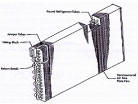 TUBE
and FIN - Oldest industry standard, 3/8-inch diameter round tube condenser.
Ok, for R12 but not recommended for R134a. This type of condenser is flushable. TUBE
and FIN - Oldest industry standard, 3/8-inch diameter round tube condenser.
Ok, for R12 but not recommended for R134a. This type of condenser is flushable.
 6
mm PICCOLO multi-flow: smaller, lightweight and more efficient than 3/8-inch
tube and fin and serpentine. Used in many domestic OE applications. This
type of condenser is flushable. 6
mm PICCOLO multi-flow: smaller, lightweight and more efficient than 3/8-inch
tube and fin and serpentine. Used in many domestic OE applications. This
type of condenser is flushable.
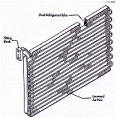 SERPENTINE:
All aluminum, more efficient than tube and fin, used on smaller imports where
space is limited. This type of condenser is not easily flushed, replacement
is recommended. SERPENTINE:
All aluminum, more efficient than tube and fin, used on smaller imports where
space is limited. This type of condenser is not easily flushed, replacement
is recommended.
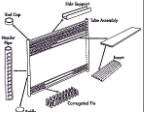 PARALLEL
FLOW: all aluminum, this efficient design breaks up flow into tiny streams that
give up heat more rapidly. This type of condenser is not flushable, replacement
only! PARALLEL
FLOW: all aluminum, this efficient design breaks up flow into tiny streams that
give up heat more rapidly. This type of condenser is not flushable, replacement
only!
 PARALLEL
FLOW with SUB Condenser. Oval tube multi-flow and sub-condenser stacked up.
Refrigerant flows through the multi-flow into the drier (called a modulator)
then continues as a liquid into the sub-condenser. This type of condenser
is not flushable, replacement only! PARALLEL
FLOW with SUB Condenser. Oval tube multi-flow and sub-condenser stacked up.
Refrigerant flows through the multi-flow into the drier (called a modulator)
then continues as a liquid into the sub-condenser. This type of condenser
is not flushable, replacement only!
Back to the FAQ
|
|
| What causes excessive clutch cycling?
It's common to assume
low refrigerant is the cause for excessive clutch cycling and this often leads
to adding refrigerant and thereby overcharging the system. Most vehicles have
a compressor clutch cutout strategy based on an engine coolant temperature of
220 - 240 degs F. The vehicles computer relies on a coolant temperature sensor
to provide the signal for the compressor clutch decision and if the sensor reads
too high the clutch will cycle off. Cooling systems with a 50-50 anti-freeze
mix and the proper radiator cap should boil at around 275 degs, so the system
may not be boiling when the compressor cuts out. Check the actual coolant mix
and temperature by using an Infrared thermometer to check coolant temperature
and a Scan Tester to tell you what temperature the sensor is actually signaling
to the computer.
Back to the FAQ
|
|
| Why should I worry about ESD?
During the testing and
repair of computer controlled vehicles we come in contact with components that
may be damaged by ElectroStaticDischarge or static electricity. When installing new electronic
components, the part itself may have developed a charge from contact with the
package during handling; therefore you need to ground yourself to the body ground
of the vehicle. This is easily done by using a wrist strap that is available
at most electronic supply stores.
Back to the FAQ
|
|
| Can compressors take all that heat?
A compressor can take
the heat, but if there's a condenser airflow problem, overcharge, poor lubrication,
restriction, etc., the temperature can greatly rise and cause the compressor
to seize. Some vehicles have compressors mounted low in the engine compartment
and due to poor airflow the compressor can overheat and fail.
Back to the FAQ
|
|
| Does it matter what oil I use?
The moving parts of a
compressor must be lubricated during operation. The oil is absorbed into the
refrigerant that carries it through the compressor as a mist. An oil over/under
charge can damage the compressor. Compatibility of refrigerant oil is determined
by its ability to remain oil when mixed with the refrigerant and not become
separated by a chemical reaction. R12 systems use a non-foaming sulfur-free
grade of mineral oil (YN-9) formulated for that refrigerant and cannot be used
in R134a systems. R134a systems use either synthetic oil (PAG) YN-12 or Double
End Capped PAG oil.
Back to the FAQ
|
|
| What are the "Three laws of Air
Conditioning"?
Everything has heat except
at absolute zero (-460 degs. F)
LAW I: to refrigerate is to remove heat - the absence of heat is cold.
LAW II: heat is ready to pass to anything that has less heat - nothing can stop
the flow, you can only slow it down
LAW III: if a change of state is to take place there must be a transfer of heat
- If a liquid is to change to a gas it must take on heat.
Back to the FAQ
|
|
| What should be done when installing
a compressor?
Flush, with an approved
solvent, to Clean the system*
Replace the Accumulator/Drier
or Orifice tube
Replace manifold sealing
washers or O-rings
Use a Vacuum Pump (20+
minutes) to remove moisture.
Add the proper amount
and type of oil. Check OEM spec
Rotate compressor hub
12 times to oil the shaft seal
Place a strong external
airflow into the condenser
Check OEM specifications
for correct refrigerant charge
Charge with VAPOR refrigerant
and with A/C and engine off.
Do a leak test and
check voltage at clutch coil
Check belt tension
and alignment
Check system operation
at 1500 RPM and mid-blower speed
Use gauges to check
the system pressures.
*Only
if the condenser is the type that can be flushed.
Back to the FAQ
|
|
| How does an automotive A/C system
work?
All matter has a certain
amount of heat except at absolute zero (-460º
F). Ice cubes feel cool to the touch, but actually it just has less heat than
your hand. Heat is transferring from your hand to the ice cube. This is the
principle behind how an A/C cools the air in a car. Heated air is circulated
across a gas filled evaporator and is transferred to the refrigerant gas making
the air less hot. The heat-laden refrigerant then is drawn into the compressor,
is super heated by compression and forced through the condenser where the cooler
outside air takes the heat from the refrigerant. Its next stop is the expansion
device (TXV or Orifice tube), which meters refrigerant into the evaporator where
it expands into a gas and it starts over again.
Back to the FAQ
|
|
| What about "Low Air Flow"?
The complaint: "it
used to blow harder". Things to check are:
Low blower motor voltage
due to a poor ground
Blower wheel loose
on motor shaft
Defective blower relay
Air leak or obstruction
in air duct system
Air mode door directing
some of the flow to the heater outlet
Icing evaporator core
due to condensation.
Debris in evaporator
housing that blocks air circulation.
Obstruction at the
air return
Back to the FAQ
|
|
| My clutch (or switch) does not function,
what can I do?
Electronic circuits are
sensitive to voltage drops and operate in narrow voltage ranges. Many connectors
have small spade or pin type connections and are engineered to have near zero
resistance. If the connection is even slightly loose it will affect the voltage.
What may seem to be a defective component could be a bad connector. The problem
may be corrosion and careful brushing or using an electrical contact cleaner
may cure it. Many OEM harness connectors are available as replacement parts.
Back to the FAQ
|
|
| Is a little moisture in the system
really such a big deal?
Moisture causes internal
icing that obstructs the orifice tube or expansion valve. This can create excessive
high pressures and low cooling. The A/C system is a closed loop system so why
does it need a Drier to remove moisture? Here's how moisture gets into the system.
Refrigerant charged through service hoses not evacuated after being connected
to the system will have air and moisture in them. Hoses left uncapped while
replacing components allows moisture to enter. Refrigerant oil is hydroscopic
(water absorbing like a sponge) and left uncapped will have moisture in it.
Recycling machines with old filters will not remove moisture from incoming refrigerant.
Condensation created when the Low side of the system gets cold and then warms
up when the system is turned off is absorbed into the system through the hoses.
Systems low on Freon will pull moisture into the system when they go into a
partial vacuum.
Back to the FAQ
|
|
| What are the basic A/C systems?
ORIFICE TUBE
SYSTEM
Orifice tube systems use an Accumulator located in the Low side of the system
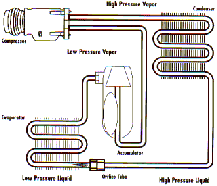
EXPANSION
VALVE SYSTEM
TXV systems use a Drier located in the High side of the system.
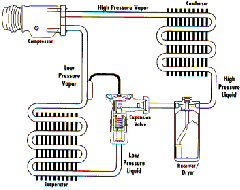
Back to the FAQ
|
|
| How are clutch cycling switches
different?
The clutch cycling switch
for R134a vehicles has been calibrated for the slightly higher pressure of R134a.
The threads, on the switch fitting, have been changed to metric to avoid connecting
to a R12 system.
Back to the FAQ
|
|
| Are your compressors compatible
with R12 or R134a refrigerant?
All of our compressors
are remanufactured with retrofitting in mind. Each compressor is remanufactured
with Nitrile or HNBR seals which allow the compressor to be installed in either
R12 or R134a refrigerant systems.
Back to the FAQ
|
